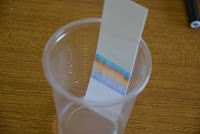Aim: To see which chemical
mix creates the most gas.
Hypothesis: (What do I think will happen)
I think the chemical mix with the most gas is the baking soda and the vinegar. I think that it is the mix because I have personally tried it, and in my opinion, I don't think that the other ones would be that strong.
Materials:
In the second mix (Bottle 2) we used 3 tsp of baking soda and 1/2 half of vinegar. We first put the baking soda in the balloon it was really hard to put it on the funnel if it is wet, that is why we just put it in the balloon. So then we put the vinegar in the bottle. Lastly we put the balloon in the bottle held the balloon up so as the baking soda would fall out. The gas went up fast and filled the balloon up, it was really big.
In the last mix (Bottle 3), here we used 3 tsp of salt and 1/2 cup of soda. The process is similar to the second mix, here we again put the salt in the balloon and the soda in the bottle. Then we again put it in the bottle and held it up for the salt to fall in the bottle. It wasn't as fast as the second mix but it still blew up the balloon.
mix creates the most gas.
Hypothesis: (What do I think will happen)
I think the chemical mix with the most gas is the baking soda and the vinegar. I think that it is the mix because I have personally tried it, and in my opinion, I don't think that the other ones would be that strong.
Materials:
- Balloon
- Bottle
- Funnel
- Yeast
- Sugar
- Baking Soda
- Vinegar
- Salt
- Soda
Steps:
- Grab a bottle, make sure it is empty and dry.
- Grab a Funnel and a balloon.
- Then Get the first two ingredients, Yeast and Sugar.
- Pour 2 tsp of the yeast and 1 tsp of sugar, make sure to pour it one at a time.
- Then wait for it to rise.
- ~Next Experiment~ Repeat the first two steps, this time grab some baking soda and vinegar.
- Pour in 3 tsp of Baking Soda in the balloon and 1/2 half cup of Vinegar in the bottle.
- Wait for the the gas to come up.
- ~Next Experiment~ Repeat the first two steps, this time grab some salt and soda.
- Pour in 3 tsp of salt in a balloon, and 1/2 half cup of soda.
- Like the other experiments wait for the gas to go up.
Findings:
Balloon 1
( 3 tsp baking soda, ½ cup vinegar)
|
Balloon 2
( 3 tsp salt, ½ cup soda)
|
Balloon 3
( 2 tsp yeast, 1 tsp sugar )
| |
Balloon Size (cm)
| 10.6cm | 5.1cm | 5.5cm |
Bubbles
| Medium Amount of Bubbles | Medium Amount of Bubbles | Large amount of Bubbles |
Conclusion:
In the first mix (Bottle 1) we used 2 tsp of yeast and 1 tsp of sugar, in that we also used warm water to dissolve the mix. It took a really long time for the balloon to go up. It also made layers, one layer was with the yeast and sugar the second was with the water and the last was with the bubbles. Throughout it had made a layer were it was brownish coloured, it looked fluffy and it had a lot of bubbles. But the balloon didn't actually go up for our group.
In the second mix (Bottle 2) we used 3 tsp of baking soda and 1/2 half of vinegar. We first put the baking soda in the balloon it was really hard to put it on the funnel if it is wet, that is why we just put it in the balloon. So then we put the vinegar in the bottle. Lastly we put the balloon in the bottle held the balloon up so as the baking soda would fall out. The gas went up fast and filled the balloon up, it was really big.
In the last mix (Bottle 3), here we used 3 tsp of salt and 1/2 cup of soda. The process is similar to the second mix, here we again put the salt in the balloon and the soda in the bottle. Then we again put it in the bottle and held it up for the salt to fall in the bottle. It wasn't as fast as the second mix but it still blew up the balloon.











